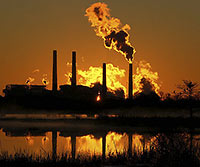W. A. PARISH PLANT ONE OF THE WORST POLLUTERS IN THE COUNTRY, FINDS REPORT  According to a new study published by Environment America, NRG Energy’s coal-firing W. A. Parish Electric Generating Plant, on Smithers Lake outside of Richmond, is really good at being dirty. Though the plant has been messing around with a way to clean itself up in the past year or so, the report, published today, still fingers it as the 5th dirtiest in the country when it comes to carbon emissions. And here, in order, are 1-4: “Georgia Power Co.’s Plant Scherer, Alabama Power Co.’s James H. Miller Jr. Plant, Luminant’s Martin Lake in Texas, [and] Ameren’s Labadie in Missouri.” [StateImpact; Environment America; previously on Swamplot] Photo: Flickr user Joe A.
According to a new study published by Environment America, NRG Energy’s coal-firing W. A. Parish Electric Generating Plant, on Smithers Lake outside of Richmond, is really good at being dirty. Though the plant has been messing around with a way to clean itself up in the past year or so, the report, published today, still fingers it as the 5th dirtiest in the country when it comes to carbon emissions. And here, in order, are 1-4: “Georgia Power Co.’s Plant Scherer, Alabama Power Co.’s James H. Miller Jr. Plant, Luminant’s Martin Lake in Texas, [and] Ameren’s Labadie in Missouri.” [StateImpact; Environment America; previously on Swamplot] Photo: Flickr user Joe A.





The larger a power plant is, the larger the emissions profile will be and these listed are some of the countries largest. CO2 (carbon dioxide) is not a pollutant but a normal occuring gas in the air that we breath. So yes, the largest power plants in the USA are emitting more emissions than the smaller ones. 1 megawatt of electricity produced with coal emits 1900 lbs co2, and 1 megawatt produced with natural gas 1100 lbs co2
Aside from CO2, burning fossil fuels releases particulate matter and smog forming organic compounds, SOX and NOX. Coincidentally, these emissions are linked so lower CO2, lower smog and particulate matter.
And btw a pollutant is “a substance or energy introduced into the environment that has undesired effects, or adversely affects on the usefulness of a resource”
While I don’t believe in the doomsday predictions of climate change, we are sprinting forward towards uncharted territory.
benny- this is a highly shortsighted and uninformed comment. Just because something occurs naturally does not disqualify said thing from being a pollutant. An increase of said thing above natural levels due to human activities and at levels which cause harm to humans is considered a ‘pollutant’ by most. Check out the dictionary definition of ‘pollutant’. I assume this means you deny climate science… I hope this is not the case because I’m hoping that you have an open mind and are not simply a product of rigid ideology.
Actually Benny’s comments are not short sighted or uninformed, that is the facts. Big coal burners have the largest carbon footprint. That is a given and is a not story. If you want to write about how dirty a plant is, you need to look a the dirty pollutants – CO, NOx, SOX, & PM-10 on a unit basis, i.e. pounds / MWh. If a 1000 MW unit is dirty, building two 500 MW units won’t make them twice as clean since they each only have half the emissions.
I did an analysis some time ago of the emissions per MW for the largest power plants in the state. Parish is far better than the rest of the large plants, as seen in this table:
Plant GHG/MW
Parish 4,652
Martin Lake 8,386
Monticello 7,383
Limestone 7,659
Sam Seymour 6,680
Welsh 6,633
Big Brown 8,233
Instead of criticizing Parish, we would be better served doing something about the other plants.
Here’s the power output for each plant:
Plant MW
Parish 3,565
Martin Lake 2,230
Monticello 1,880
Limestone 1,706
Sam Seymour 1,690
Welsh 1,674
Big Brown 1,150
And the total GHG by plant (not sure if this is tons or pounds, I can’t find the source document right now):
Plant GHG
Parish 16,583,228
Martin Lake 18,701,286
Monticello 13,880,166
Limestone 13,066,969
Sam Seymour 11,289,000
Welsh 11,103,023
Big Brown 9,468,521
Thanks to all for the added comments, I learned something from each of them. My point is that I think the media unfairly labels CO2 as “dirty” when it isn’t such at all. The other plants listed, Martin Lake and some others burn local Lignite which is low grade coal, so you need more of it to make 1 megawatt power and hence more CO2. I am not against global warming but I do keep it in perspective. These are the contents of the air we breath and as you can see CO2 is three 100ths of one percent. What truly makes air bad for us is the airborne particulates, like SOX, NOX, and Mercury that get inhaled and stuck in our lungs. Further CO2 is known as a heat trapping gas, however vented Methane has 60 times more heat trapping ability and water vapor has 20 times more heat trapping ability than our “dirty villain” CO2. I’m not absolutely sure but I think WA Parish burns both coal and nat gas in separate burners based on which is cheaper.
Nitrogen 78.08
Oxygen 20.95
Argon 0.93
Carbon dioxide 0.03
Neon 0.0018
Helium 0.0005
Krypton 0.0001
Xenon 0.00001
Benny, the Clean Air Act defines a pollutant as “any air pollution agent or combination of such agents, including any physical, chemical, biological, radioactive . . . substance or matter which is emitted into or otherwise enters the ambient air.”
In 2007, the U.S. Supreme Court in Massachusetts v. EPA found that CO2 (and potentially other greenhouse gases) are pollutants, at least for the purposes of regulation under the Clean Air Act.
I think the word “dirty” in the post has thrown you off here. Coal plants produce a lot of things that make us think about in terms of dirtiness – particulate matter, mercury, precursors to ozone, etc. But while not dirty, CO2 is a pollutant.
More CO2 in the atmosphere is not necessarily a bad thing. Nature has a way of balancing things out. If you think that the small amount of C02 created by our power plants is a threat to nature then you don’t have much respect for nature.
Jgriff:
If mother nature can always “balance things out”, it may not be on a time scale that suits human civilization or agriculture.
.
Questions for you: if mother nature always balances things out, why have CO2 levels gone up? Shouldn’t they have been kept even by mother nature? Sure, plants grow better with more CO2, the oceans should have been absorbing some of that CO2, blah, blah, blah. If your explanation works, why are atmospheric CO2 levels still going up? Are they not high enough YET for mother nature to do something about?
.
The oceans have become measurably more acidic over the last 200 years from CO2 absorption, but they can’t absorb CO2 fast enough to “balance things out”.
Will this great “balancing out” by mother nature occur before, or after we render the planet uninhabitable to the majority of humans?
That’s a rather important question to know the answer to before blithely shrugging that nature will just adjust to the changes we render.
FACT: ANYONE, that lives immediately around, or NW of the W.A. Parish plant (prevailing winds are from SW) is subject to inhaling dramatic increases of PM10, and thus shorter life spans.